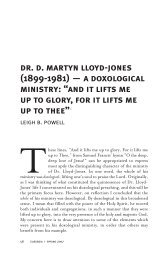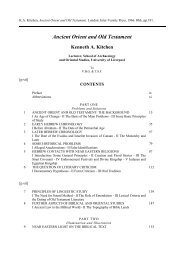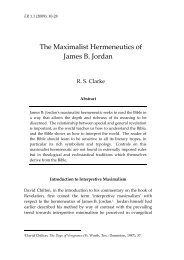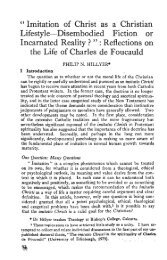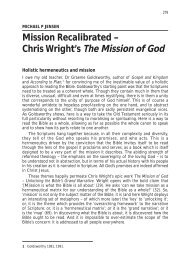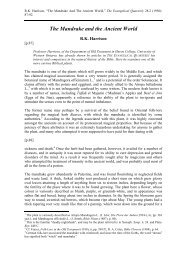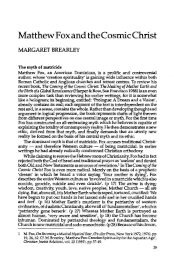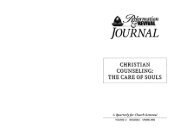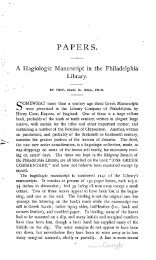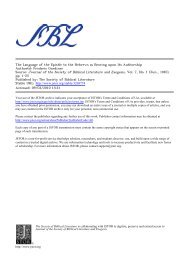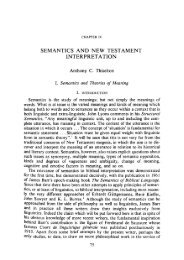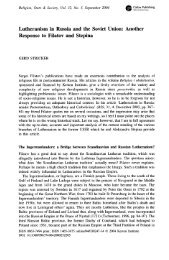Angus of the Hills (c.1809-c.1854) - BiblicalStudies.org.uk
Angus of the Hills (c.1809-c.1854) - BiblicalStudies.org.uk
Angus of the Hills (c.1809-c.1854) - BiblicalStudies.org.uk
Create successful ePaper yourself
Turn your PDF publications into a flip-book with our unique Google optimized e-Paper software.
102 DOUGLAS W. B. SOMERSET<br />
manual labour. This agrees with Mrs Bishop’s description: “<strong>Angus</strong> was<br />
ra<strong>the</strong>r under <strong>the</strong> average height, slight, loosely built, thin, <strong>of</strong> a very<br />
wea<strong>the</strong>r-worn appearance.” Mrs Bishop says that “usually his gait was<br />
uncertain, his fingers and limbs were subject to twitches and movements,<br />
as if under <strong>the</strong> working <strong>of</strong> his thoughts uncontrolled; but when engrossed<br />
in prayer or in spiritual conversation <strong>the</strong>re was a calmness, a serious<br />
absorption, which overcame and did away with any ungainliness <strong>of</strong><br />
bearing”. It is easy to imagine that she is describing <strong>the</strong> person in <strong>the</strong><br />
picture. She says, too, that “<strong>Angus</strong> had an unconquerable aversion to<br />
wearing a bonnet, he always kept his head bare”. Again, <strong>the</strong> person<br />
in <strong>the</strong> picture has no hat (though men were generally photographed<br />
without hats at that stage). All <strong>the</strong>se small details help to confirm <strong>the</strong><br />
identification <strong>of</strong> <strong>the</strong> photograph. 37<br />
The question <strong>of</strong> when and where <strong>the</strong> photograph was taken is<br />
difficult. At this point a brief digression on <strong>the</strong> early history <strong>of</strong><br />
photography is necessary. The first photographs date from <strong>the</strong> 1820s,<br />
and <strong>the</strong> first Scottish photographs from <strong>the</strong> 1840s. The two original<br />
processes were <strong>the</strong> daguerreotype and <strong>the</strong> calotype. The daguerreotype was<br />
introduced in 1839 and yielded an image on a metallic surface. The<br />
image had remarkable detail but it was expensive, required very long<br />
exposure times, could not be reproduced, was laterally inverted, and<br />
could only be viewed from selected angles. It was also fragile and had to<br />
be sealed behind glass to protect it from <strong>the</strong> air.<br />
The calotype was introduced by Fox Talbot in <strong>the</strong> autumn <strong>of</strong> 1840.<br />
It was patented in England, but <strong>the</strong> patent restriction did not extend to<br />
Scotland where it became popular among enthusiasts. D. O. Hill and<br />
Robert Adamson took calotype pictures <strong>of</strong> most <strong>the</strong> leading figures <strong>of</strong><br />
<strong>the</strong> Free Church after <strong>the</strong> Disruption <strong>of</strong> 1843. The calotype produced an<br />
image on paper and was less detailed than <strong>the</strong> daguerreotype but<br />
cheaper. It involved a negative, which allowed <strong>the</strong> production <strong>of</strong> multiple<br />
copies, but <strong>the</strong> quality <strong>of</strong> <strong>the</strong> copy depended on <strong>the</strong> paper <strong>of</strong> <strong>the</strong> negative,<br />
and minute defects, such as an area where <strong>the</strong> paper was slightly thinner,<br />
could ruin <strong>the</strong> picture.<br />
In March 1851, Frederick Archer published in The Chemist a<br />
description <strong>of</strong> a new method, <strong>the</strong> collodion process, which used a glass<br />
plate for <strong>the</strong> negative ra<strong>the</strong>r than paper. The collodion process was about<br />
a twentieth <strong>the</strong> price <strong>of</strong> <strong>the</strong> daguerreotype, and much simpler than <strong>the</strong><br />
37 Sunday at Home, pp. 70-1.




